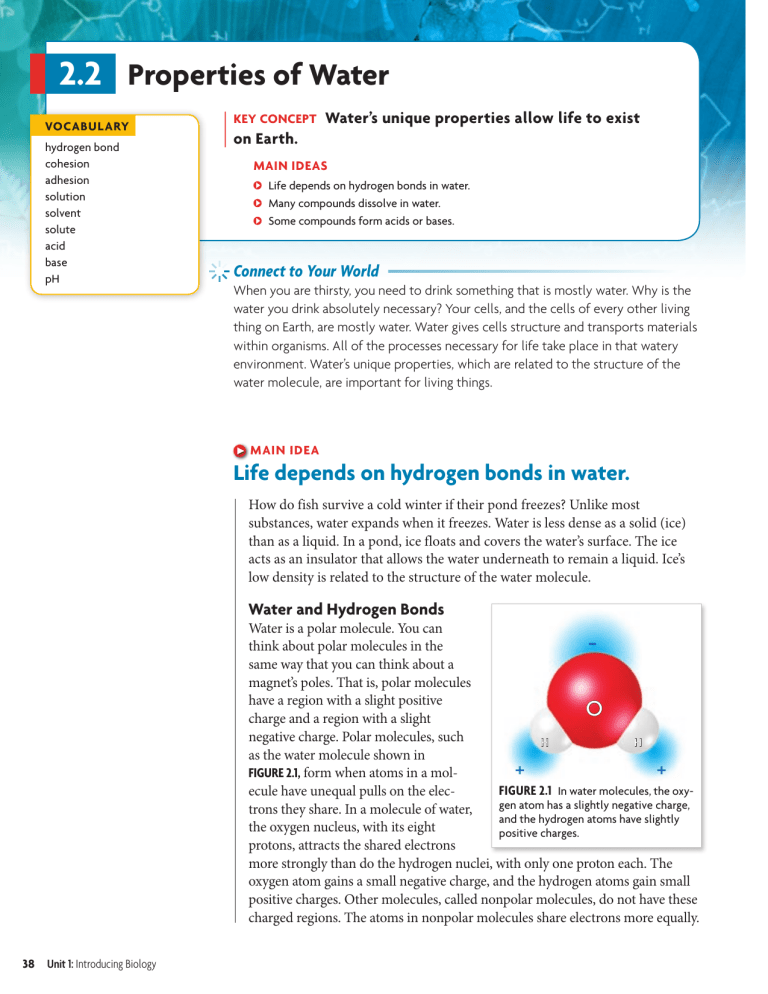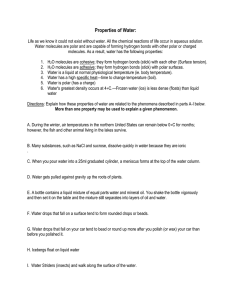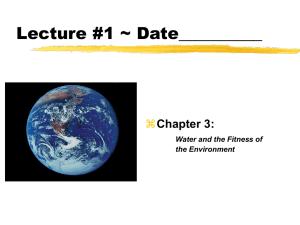Properties of Water: Hydrogen Bonds, Solutions, Acids/Bases
advertisement

2.2 Properties of Water VOCABULARY hydrogen bond cohesion adhesion solution solvent solute acid base pH > Key Concept Water’s unique properties allow life to exist on Earth. MAIN IDEAS Life depends on hydrogen bonds in water. Many compounds dissolve in water. Some compounds form acids or bases. Connect to Your World When you are thirsty, you need to drink something that is mostly water. Why is the water you drink absolutely necessary? Your cells, and the cells of every other living thing on Earth, are mostly water. Water gives cells structure and transports materials within organisms. All of the processes necessary for life take place in that watery environment. Water’s unique properties, which are related to the structure of the water molecule, are important for living things. MAIN IDEA Life depends on hydrogen bonds in water. How do fish survive a cold winter if their pond freezes? Unlike most substances, water expands when it freezes. Water is less dense as a solid (ice) than as a liquid. In a pond, ice floats and covers the water’s surface. The ice acts as an insulator that allows the water underneath to remain a liquid. Ice’s low density is related to the structure of the water molecule. Water and Hydrogen Bonds Water is a polar molecule. You can think about polar molecules in the same way that you can think about a magnet’s poles. That is, polar molecules have a region with a slight positive O charge and a region with a slight negative charge. Polar molecules, such H H as the water molecule shown in + + figure 2.1, form when atoms in a molFIGURE 2.1 In water molecules, the oxyecule have unequal pulls on the elecbhspe-010202-002 gen atom has a slightly negative charge, trons they share. In a molecule of water, and the hydrogen atoms have slightly the oxygen nucleus, with its eight positive charges. protons, attracts the shared electrons more strongly than do the hydrogen nuclei, with only one proton each. The oxygen atom gains a small negative charge, and the hydrogen atoms gain small positive charges. Other molecules, called nonpolar molecules, do not have these charged regions. The atoms in nonpolar molecules share electrons more equally. - 38 Unit 1: Introducing Biology Opposite charges of polar molecules can interact to form hydrogen bonds. A hydrogen bond is an attraction between a slightly positive hydrogen atom and a slightly negative atom, often oxygen or nitrogen. Hydrogen bonding is shown among water molecules in Figure 2.2, but these bonds are also found in many other molecules. For example, hydrogen bonds are part of the structures of proteins and of DNA, which is the genetic material for all organisms. Biology HMDScience.com + Premium Content + Hydrogen Bonding + - + – + + hydrogen bond – (tr) ©Gary Meszaros/Photo Researchers, Inc.; (br) ©Sinclair Stammers/Photo Researchers, Inc. Properties Related to Hydrogen Bonds Individual hydrogen bonds are about 20 times weaker than typical covalent bonds, but they are relatively strong among water molecules. As a result, a large amount of energy is needed to overcome the attractions among water molecules. Without hydrogen bonds, water would boil at a much lower temperature than it does because less energy would be needed to change liquid water into water vapor. Water is a liquid at the temperatures that support most life on Earth only because of hydrogen bonds in water. Hydrogen bonds are responsible for three important properties of water. • High specific heat Hydrogen bonds give water an abnormally high specific heat. This means that water resists changes in temperature. Compared to many other compounds, water must absorb more heat energy to increase in temperature. This property is very important in cells. The processes that produce usable chemical energy in cells release a great deal of heat. Water absorbs the heat, which helps to regulate cell temperatures. • Cohesion The attraction among molecules of a substance is cohesion. Cohesion from hydrogen bonds makes water molecules stick to each other. You can see this when water forms beads, such as on a recently washed car. Cohesion also produces surface tension, which makes a kind of skin on water. Surface tension keeps the spider in FIGURE 2.2 from sinking. • Adhesion The attraction among molecules of different substances is called adhesion. In other words, water molecules stick to other things. Adhesion is responsible for the upward curve on the surface of the water in figure 2.3 because water molecules are attracted to the glass of the test tube. Adhesion helps plants transport water from their roots to their leaves because water molecules stick to the sides of the vessels that carry water. Figure 2.2 Water’s surface tension comes from hydrogen bonds (left) that cause water molecules to stick together. Figure 2.3 The water’s surface (left, dyed red) is curved down because water has greater adhesion than cohesion. The surface of the mercury (right) is curved up because mercury has greater cohesion than adhesion. Compare How are hydrogen bonds similar to ionic bonds? MAIN IDEA Many compounds dissolve in water. Molecules and ions cannot take part in chemical processes inside cells unless they dissolve in water. Important materials such as sugars and oxygen cannot be transported from one part of an organism to another unless they are dissolved in blood, plant sap, or other water-based fluids. Chapter 2: Chemistry of Life 39 Many substances dissolve in the VISUAL VOCAB water in your body. When one subThe solvent is the substance that is stance dissolves in another, a solution present in the greatest amount, and is forms. A solution is a mixture of the substance that dissolves solutes. substances that is the same throughsolvent out—it is a homogeneous mixture. A solution has two parts. The solvent is solution the substance that is present in the solute greater amount and that dissolves A solute is the substance that dissolves. another substance. A solute is a substance that dissolves in a solvent. The amount of solute dissolved in a certain amount of solvent is a solution’s concentration. One spoonful of a drink mix in water has little flavor because it has a low concentration. But a solution with four spoonfuls in the same amount of water tastes stronger because it has a higher concentration. Figure 2.4 A mosquito solution in injects a solution containing a protein solute that prevents blood from clotting. The mosquito solution out sucks in blood, which is a solution containing solutes such as ions, sugars, and proteins. The liquid part of your blood, called plasma, is about 95 percent water. Therefore, the solvent in plasma is water and all of the substances dissolved in it are solutes. Most of these solutes, such as sugars and proteins, dissolve in the water of blood plasma because they are polar. Polar molecules dissolve in water because the attraction between the water molecules and the solute molecules is greater than the attraction among the molecules of the solute. Similarly, ionic compounds, such as sodium chloride, dissolve in water because the charges of the water molecules attract the charges of the ions. The water molecules surround each ion and pull the compound apart. Nonpolar substances, such as fats and oils, rarely dissolve in water. Nonpolar molecules do not have charged regions, so they are not attracted to polar molecules. Polar molecules and nonpolar molecules tend to remain separate, which is why we say, “Oil and water don’t mix.” But nonpolar molecules will dissolve in nonpolar solvents. For example, some vitamins, such as vitamin E, are nonpolar and dissolve in fat in your body. Connect What are the solvent and solutes in a beverage you drink? MAIN IDEA Some compounds break up into ions when they dissolve in water. An acid is a compound that releases a proton—a hydrogen ion (H+)—when it dissolves in water. An acid increases the concentration of H+ ions in a solution. Bases are compounds that remove H+ ions from a solution. When a base dissolves in water, the solution has a low H+ concentration. A solution’s acidity, or H+ ion concentration, is measured by the pH scale. In Figure 2.5 you can see that pH is usually between 0 and 14. A solution with a pH of 0 is very acidic, with a high H+ concentration. A solution with a pH of 14 is very basic, with a low H+ concentration. Solutions with a pH of 7 are neutral—neither acidic nor basic. 40 Unit 1: Introducing Biology ©Roger Eritja/Alamy Some compounds form acids or bases. FIGURE 2.5 Understanding pH The pH of a solution depends on the concentration of H+ ions. stomach acid pH between 1 and 3 pH 0 1 2 3 4 blood pH 7.4 bile pH between 8 and 9 pure water pH 7 5 6 more acidic 7 8 9 10 11 12 13 pH 14 more basic neutral The concentration of H+ ions varies depending on how acidic or basic a solution is. + H+ H+ H+ H+ H H+ H+ H+ H+ H+ H+ H+ H+ H+ H+ H+ + H+ H+ H H+ high+ H+ + + + H H H+ H H concentration H+ H+ H+ + + + H H H H+ H+ H+ H+ H+ H+ H+ H+ H+ H+ H+ H+ H+ H+ H+ H+ H+ H+ H+ H+ H+ H+ low H+ concentration H+ H+ H+ H+ H+ H+ H+ H+ Summarize Describe the relationship between the H+ concentration and the pH value. Most organisms, including humans, need to keep their pH within a very narrow range around neutral (pH 7.0). However, some organisms need a very different pH range. The azalea plant thrives in acidic (pH 4.5) soil, and a microorganism called Picrophilus survives best at an extremely acidic pH of 0.7. For all of these different organisms, pH must be tightly controlled. One way pH is regulated in organisms is by substances called buffers. A buffer is a compound that can bind to an H ion when the H+ concentration increases, and can release an H ion when the H concentration decreases. In other words, a buffer “locks up” H ions and helps to maintain homeostasis. For example, the normal pH of human blood is between 7.35 and 7.45, so it is slightly basic. Just a small change in pH can disrupt processes in your cells, and a blood pH greater than 7.8 or less than 6.8, for even a short time, is deadly. Buffers in your blood help prevent any large changes in blood pH. CONNECT TO Human Biology In the human body, both the respiratory system and the excretory system help regulate pH. You will learn about human systems and homeostasis in Human Systems and Homeostasis. Apply Cells have higher H+ concentrations than blood. Which has a higher pH? Why? Self-check Online 2.2 Formative Assessment Reviewing Main Ideas 1. How do polar molecules form hydrogen bonds? 2. What determines whether a com­ pound will dissolve in water? 3. Make a chart that compares acids and bases. Critical thinking 4. Compare and Contrast How do polar molecules differ from non-polar molecules? How does this difference affect their interactions? 5. Connect Describe an example of cohesion or adhesion that you might observe during your daily life. HMDScience.com Premium Content CONNECT TO Cellular Respiration 6. When sugars are broken down to produce usable energy for cells, a large amount of heat is released. Explain how the water inside a cell helps to keep the cell’s temperature constant. Chapter 2: Chemistry of Life 41





